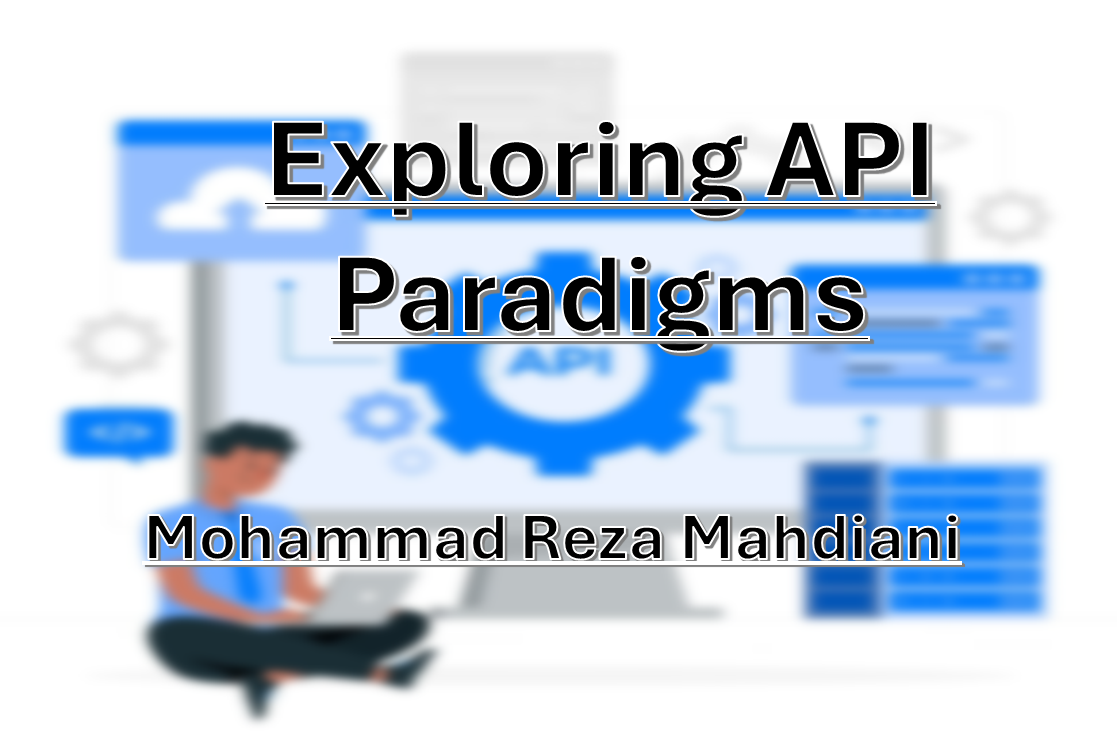Exploring API Paradigms
 Mohammad Reza Mahdiani
Mohammad Reza Mahdiani
Exploring API Paradigms: REST, GraphQL, WebSockets, and Beyond
In today's interconnected digital world, APIs (Application Programming Interfaces) are the backbone of communication between applications. From fetching data to enabling real-time communication, APIs come in various types, each with its strengths, weaknesses, and ideal use cases.

Let's dive into the most common API paradigms, their unique features, and when to use each.
1. REST (Representational State Transfer)

REST APIs follow architectural principles and use HTTP methods (GET, POST, PUT, DELETE) to interact with resources.
Advantages:
- Simplicity: Easy to understand and widely adopted.
- Language Agnostic: Works with any language supporting HTTP.
- Stateless: Scalable and reduces server overhead.
Disadvantages:
- Over-fetching or Under-fetching: Clients may get too much or too little data.
- Limited Real-time Capabilities: Not suited for real-time updates.
Use Cases:
- CRUD applications (e.g., e-commerce platforms, blogs).
- Scenarios with well-defined resource structures.
2. GraphQL
GraphQL, developed by Facebook, allows clients to request precisely the data they need.
Advantages:
- Efficient Data Fetching: Reduces over-fetching/under-fetching.
- Strong Typing: Built-in schema validation.
- Single Endpoint: Eliminates multiple API calls.
Disadvantages:
- Complexity: Requires careful schema management.
- Caching Challenges: Difficult to implement caching strategies.
Use Cases:
- Applications with complex data needs (e.g., mobile apps, dashboards).
- Systems requiring flexibility in data retrieval.
3. WebSocket
WebSocket APIs enable bi-directional, full-duplex communication between clients and servers.
Advantages:
- Real-time Updates: Ideal for live data streams.
- Low Latency: Reduces delay in communication.
Disadvantages:
- Complexity: Setup and debugging can be challenging.
- Resource Intensive: Requires persistent connections.
Use Cases:
- Real-time applications (e.g., chat apps, online gaming, stock tickers).
- Scenarios needing continuous data exchange.
4. RPC (Remote Procedure Call)
RPC allows clients to execute a procedure on a server as if it were local. Common examples include gRPC (Google RPC).
Advantages:
- High Performance: Uses binary protocols for faster communication.
- Streaming Support: Supports real-time data exchange.
Disadvantages:
- Steeper Learning Curve: Complex implementation.
- Language Binding: May require specific language bindings.
Use Cases:
- Microservices communication.
- High-performance applications (e.g., video streaming, machine learning pipelines).
5. SOAP (Simple Object Access Protocol)
SOAP is a protocol-based API that uses XML for message formatting.
Advantages:
- Strict Standards: Reliable and secure.
- Built-in Error Handling: Comprehensive fault reporting.
Disadvantages:
- Verbosity: XML increases payload size.
- Performance Overhead: Slower than modern alternatives.
Use Cases:
- Enterprise applications requiring high reliability (e.g., banking, healthcare).
Choosing the Right API
When selecting an API for your project, consider these factors:
- Data Complexity: Does your application require flexible or predefined data structures?
- Real-time Needs: Will your app benefit from live updates?
- Performance: Are speed and low latency critical?
- Ecosystem Fit: Does the API align with your existing stack?
Understanding these paradigms enables developers and tech leaders to make informed decisions tailored to their project's requirements.
What’s Your Take?
What API paradigm have you found most effective in your projects? Are there scenarios where one type outperforms the others?
Share your experiences in the comments below!
Also, feel free to suggest topics you'd like me to explore in future articles.
Subscribe to my newsletter
Read articles from Mohammad Reza Mahdiani directly inside your inbox. Subscribe to the newsletter, and don't miss out.
Written by

Mohammad Reza Mahdiani
Mohammad Reza Mahdiani
I am a results-driven Senior Developer and Machine Learning Specialist with a proven track record of leading high-performing teams and delivering innovative solutions. With extensive experience in software development and a passion for cutting-edge technologies, I specialize in creating scalable, efficient, and impactful systems that drive business growth. As a team leader, I thrive on empowering and mentoring my team, fostering a collaborative environment to solve complex challenges. My expertise in machine learning allows me to design and deploy intelligent systems that harness data to unlock insights, automate processes, and enhance user experiences. I'm passionate about staying ahead of industry trends and continuously evolving my skill set to align with the future of technology. If you're seeking a dedicated professional who combines technical expertise with strategic vision, let's connect!